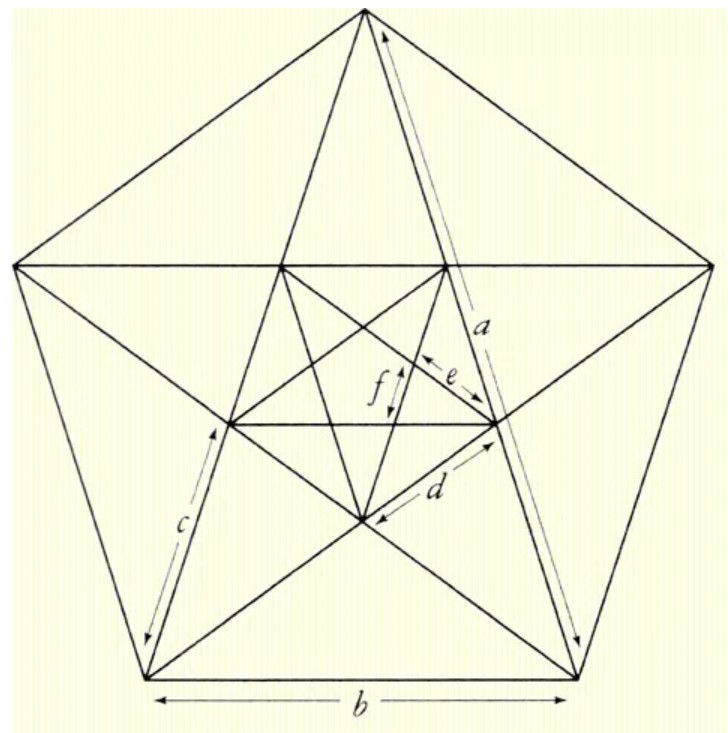The Pentagram of Pythagoras
"Pythagoras was the first of the great teachers of ancient Greece. Born in 580 B.C., Pythagoras became one of the most well known philosophers and mathematicians in history. Creating the Pythagorean Brotherhood, his teachings greatly influenced Socrates, Plato, and Aristotle. Pythagoras is considered as the first pure mathematician; he also founded a community/society based on religion and science. He is most widely known as the author of the Pythagorean Theorem. Some even venture to believe that the word “philosophy” was invented by Pythagoras. He claimed to be a lover of wisdom, for which the Greek word philo means love and Sophia means wisdom.
The Teachings of Pythagoras revolved around the idea that when considering the deepest level, reality is essentially mathematical in nature. Pythagoreans believed there was a system of principles that existed behind numbers. The principles form a foundation for many concepts of traditional Western thought. One of his most basic notions revolves around the symbolism and beauty associated with the Divine Proportion.
The shape of the pentad follows as the symbol of life itself. The pentad consists of all previous numerical symbols: monad’s point, the dyad’s line, the triad’s surface, and the tetrad’s three dimensional volume. The pentad also refers to the well known five point star. The pentad arises in the existence of our five fingers, five toes, the symbol that wards off evil, and a symbol for power and immunity. Because of the importance of the pentad, the construction of the symbol was first kept secret from society. The pentad was used as a secret sign among the Pythagoreans for them to distinguish themselves and recognize other members.
The pentad’s symbolism can be directly related to the Divine Proportion. And the regeneration of the pentad is related to the value of phi (Ф). The image of the pentad is found in nature in leaves and flowers. The Greeks believed each point of the pentad to represent an element: water, earth, air, fire, and idea.
At any rate all his [Pythagoras'] school in serious letters to each other began straightway with 'Health to you,' as a greeting most suitable for both body and soul, encompassing all human goods. Indeed the Pentagram, the triple intersecting triangle which they use as a symbol of their sect, they called 'Health'.
Johannes Kepler (1571-1630) wrote: "Geometry has two great treasures; one is the Theorem of Pythagoras; the other, the division of a line into extreme and mean ratio. The first we may compare to a measure of gold; the second we may name a precious jewel."
...
"The axial structure of B-DNA is shown in Figures 2 and 4. The rotation of each base pair by 36◦, in the canonical B-DNA molecule, gives a complete 360◦ rotation every 10 base pairs and results in a decagonal structure and ten-fold rotational symmetry. These properties alone relate the axial structure of the molecule to Φ. Although a molecule with a decagonal form might be expected to show some simple relationship to Φ, and while there is always a danger in seeing patterns where there may be none, the axial form of B-DNA is neatly encompassed by 10 “golden diamonds” (refer Figure 1), the template of which is shown in Figure 4B, and overlaid on Figure 4A such that points (a) and (c) are located on the outermost hydrogens and point (b) is between the outer oxygen atoms."
...
"The ancient Greek followers of the mathematician Pythagoras kept the shape as their secret symbol, a signifier of wholeness or divine blessing. Nature.
The pentagram was a symbol, but also a window of sorts. It's not a shape so much as it is a relationship. Within it we find the Golden Ratio.
The Ratio is noted for both its seemingly fundamental aesthetic appeal and its (seemingly) persistent recurrence in natural and manmade systems, from plant biology to financial markets to human DNA.
It's a way of cutting up a line that appears to be preferred by nature, anyhow. Note that every time a line crosses another line, as in the sketch below, it results in a Golden Ratio relationship between the two resulting segments. So, follow a pentagram edge down until it hits the start of another point; that corner is a Golden joint of sorts.
It's possible to connect the points of a pentagram to come up with a new pentagon and, from the new pentagon, a new pentagram. And this can go on forever:
Presumably, the Pythagoreans spent a whole lot of time staring deeply into pentagrams. Tradition has it that a young Pythagorean, Hippasus of Metapontum, was doing just that when he happened up the first proof of the existence of irrational numbers, a startling revelation for the "all is number" crowd.
Hippasus noted what you see above, that the inner core of a pentagram is a pentagon, and inside of that could be found a new pentagram. Clearly, this went on pretty much forever. And it had to, which is what was eventually proved by the Greek.
Imagine Hippasus gazing into the trippy arrangement of nested pentagrams above. Each one lives within a pentagon, with its dimensions limited by that pentagon. All of these shapes clearly live within some hard and fast relationship; they define each other. That relationship is what we'd normally think of as a ratio. One shape is to the other as some quantity a is to some quantity b."
-taken from jwilson.coe.uga.edu, MDPI, freemasonrymatters, and vice (also watch the Disney video featuring Donald Duck below first picture)
 |
| The Pentagram of Pythagoras. |
 |
| Excerpt DNA Structure and the Golden Ratio Revisited by Stuart Henry Larsen. |
 |
| The "Golden Ratio". |
 |
| Experiencing Architecture, second edition by Steen Eiler Rasmussen, page 107. |
Source/Quote:
https://www.vice.com/en/article/wnjzvz/how-math-becomes-noisy
https://www.mdpi.com/2073-8994/13/10/1949
http://jwilson.coe.uga.edu/EMAT6680Fa06/Hobgood/Pythagoras.html
https://mitpress.mit.edu/books/experiencing-architecture-second-edition



Comments
Post a Comment